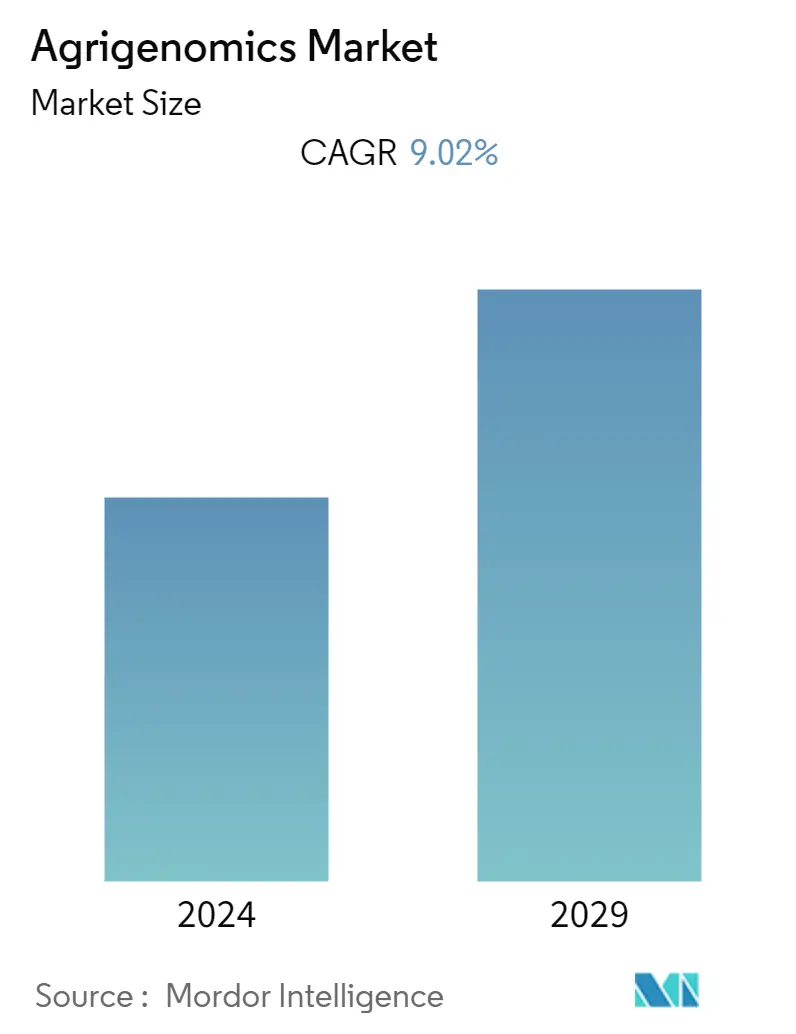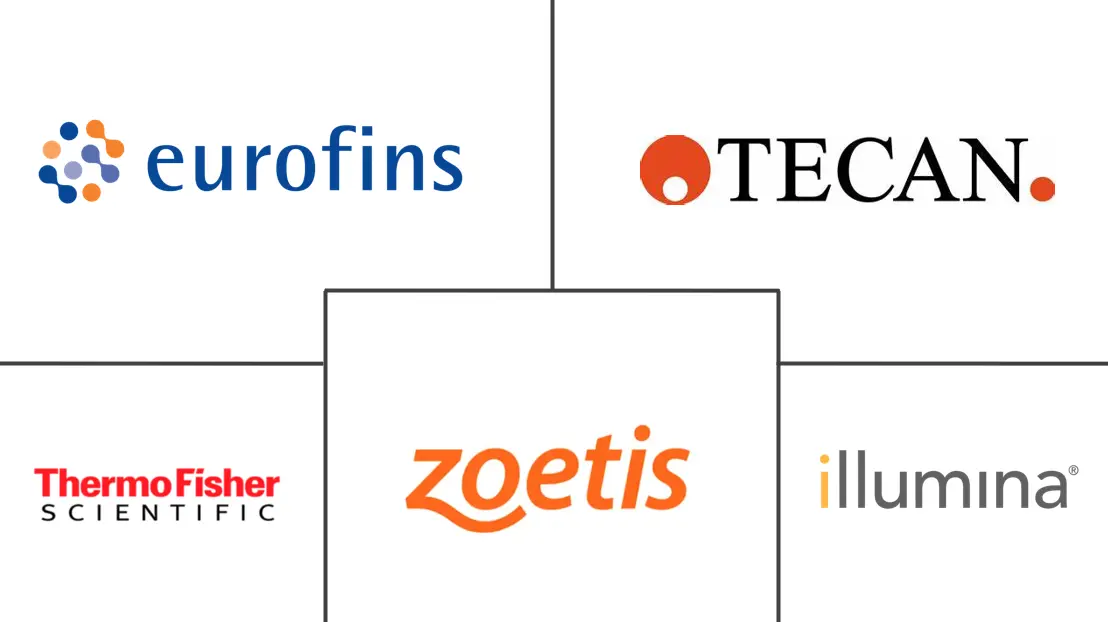Market Size of Agrigenomics Industry

| Study Period | 2019 - 2029 |
| Base Year For Estimation | 2023 |
| CAGR | 9.02 % |
| Fastest Growing Market | Asia Pacific |
| Largest Market | North America |
| Market Concentration | Medium |
Major Players
*Disclaimer: Major Players sorted in no particular order |
Agrigenomics Market Analysis
The Agrigenomics Market size is expected to grow from USD 3.96 billion in 2023 to USD 6.10 billion by 2028, at a CAGR of 9.02% during the forecast period (2023-2028).
- Agrigenomics is the study of plants' genetic makeup and how the genes contribute to crop production. Microarray and next-generation sequencing (NGS) technologies are helping breeders and researchers evaluate and predict genetic merit in plants and animals, informing crucial decisions about selection and health. The research aims to completely understand yield optimization, plant evolution, disease resistance, phylogenetic relationships, pest control, stress tolerance, and food and biofuel optimization.
- The rising applications of agrigenomics in routine agriculture activities, the increasing number of deoxyribonucleic acid/ribonucleic acid (DNA/RNA) sequencing project grants, and technological developments in genomics and agriculture are some of the key drivers expected to drive market growth during the forecast period. The other factors supporting the growth of the global agrigenomics market are the increasing food consumption volume due to the increasing population, the growing use of advanced tools and techniques of genome research testing, and rising investments in research & development activities by government-funded organizations.
- Illumina technology has become increasingly popular in agriculture for developing high-yielding genomics in livestock and crops. This technology enables researchers and breeders to identify genetic variations responsible for desirable traits, such as disease resistance, increased productivity, and improved quality. By sequencing the genomes of various organisms and analyzing the data using Illumina technology, researchers can identify specific genes and genetic markers associated with these traits, which can then be used to develop new and improved strains of crops and livestock. Microarray and next-generation sequencing (NGS) technologies are useful for studying various aspects of plant and animal genomics, including genotype, gene expression and regulation, and epigenetics. These approaches offer the throughput, sensitivity, and precision needed to evaluate genetic markers and discover new ones associated with traits or diseases.
- The increase in applications of genome sequencing in livestock not only enables the study of parent lineage but also aids in understanding the characteristics of infectious agents, such as bacteria and viruses that infest them or live on them. The resolution of the next-generation sequencing enables researchers to study the mutations in infectious agents over time, and help in understanding the transmission patterns of these diseases, thereby contributing to the development of effective treatment.
Agrigenomics Industry Segmentation
Agrigenomics is the application of genomics and bioinformatics technologies to agriculture. It involves the use of high-throughput sequencing, gene editing, and other genetic techniques to study and improve agricultural crops, livestock, and other agricultural products.
The agrigenomics market is segmented by technology into real-time PCR (qPCR), microarrays, next generation sequencing, capillary electrophoresis, and other technologies, application into crops and livestock, service offerings into genotyping, DNA fingerprinting, assessment of genetic purity, trait purity assessment, gene expression analysis, and other service offerings, and geography into North America, Europe, Asia-Pacific, South America, and Middle East and Africa.
The market sizing has been done in value terms in USD for all the abovementioned segments.
| Technology | |
| Real-Time PCR (qPCR) | |
| Microarrays | |
| Next Generation Sequencing | |
| Capillary Electrophoresis | |
| Other Technologies |
| Application | |
| Crops | |
| Livestocks |
| Service Offerings | |
| Genotyping | |
| DNA Fingerprinting | |
| Assessment of Genetic Purity | |
| Trait Purity Assessment | |
| Gene Expression Analysis | |
| Other Service Offerings |
| Geography | ||||||||
| ||||||||
| ||||||||
| ||||||||
| ||||||||
|
Agrigenomics Market Size Summary
The agrigenomics market is poised for significant expansion, driven by advancements in genetic research technologies such as microarray and next-generation sequencing (NGS). These technologies are instrumental in enhancing crop and livestock productivity by enabling the identification of genetic markers associated with desirable traits like disease resistance and increased yield. The growing application of agrigenomics in agriculture is fueled by the need to meet the rising global food demand, exacerbated by population growth and challenges such as climate change and resource scarcity. The sector is witnessing increased investment in research and development, supported by government initiatives and funding, which are crucial for developing sustainable agricultural practices and improving food security.
In North America, the agrigenomics market is experiencing steady growth due to the adoption of genetically engineered seed varieties that reduce pesticide use and enhance crop resilience. The region's market expansion is further supported by strong research and development activities, mergers and acquisitions, and the widespread acceptance of genetically modified crops. Key players in the market, including Eurofins Scientific, Thermo Fisher Scientific, Illumina, Zoetis, and Tecan Genomics, are focusing on strategic partnerships, new product launches, and technological innovations to maintain their competitive edge. These efforts are aimed at advancing agrigenomic technologies to optimize agricultural productivity and address the challenges posed by a growing global population.
Agrigenomics Market Size - Table of Contents
-
1. MARKET DYNAMICS
-
1.1 Market Overview
-
1.2 Market Drivers
-
1.3 Market Restraints
-
1.4 Porter's Five Forces Analysis
-
1.4.1 Bargaining Power of Suppliers
-
1.4.2 Bargaining Power of Buyers/Consumers
-
1.4.3 Threat of Substitute Products
-
1.4.4 Threat of New Entrants
-
1.4.5 Intensity of Competitive Rivalry
-
-
-
2. MARKET SEGMENTATION
-
2.1 Technology
-
2.1.1 Real-Time PCR (qPCR)
-
2.1.2 Microarrays
-
2.1.3 Next Generation Sequencing
-
2.1.4 Capillary Electrophoresis
-
2.1.5 Other Technologies
-
-
2.2 Application
-
2.2.1 Crops
-
2.2.2 Livestocks
-
-
2.3 Service Offerings
-
2.3.1 Genotyping
-
2.3.2 DNA Fingerprinting
-
2.3.3 Assessment of Genetic Purity
-
2.3.4 Trait Purity Assessment
-
2.3.5 Gene Expression Analysis
-
2.3.6 Other Service Offerings
-
-
2.4 Geography
-
2.4.1 North America
-
2.4.1.1 United States
-
2.4.1.2 Canada
-
2.4.1.3 Mexico
-
2.4.1.4 Rest of North America
-
-
2.4.2 Europe
-
2.4.2.1 Germany
-
2.4.2.2 United Kingdom
-
2.4.2.3 France
-
2.4.2.4 Russia
-
2.4.2.5 Spain
-
2.4.2.6 Rest of Europe
-
-
2.4.3 Asia Pacific
-
2.4.3.1 China
-
2.4.3.2 Japan
-
2.4.3.3 India
-
2.4.3.4 Rest of Asia-Pacific
-
-
2.4.4 South America
-
2.4.4.1 Brazil
-
2.4.4.2 Argentina
-
2.4.4.3 Rest of South America
-
-
2.4.5 Middle East and Africa
-
2.4.5.1 South Africa
-
2.4.5.2 Rest of Middle East and Africa
-
-
-
Agrigenomics Market Size FAQs
What is the current Agrigenomics Market size?
The Agrigenomics Market is projected to register a CAGR of 9.02% during the forecast period (2024-2029)
Who are the key players in Agrigenomics Market?
Eurofins Scientific Se, Thermo Fisher Scientific' Inc., Illumina' Inc, Zoetis' Inc and Tecan Genomics, Inc. are the major companies operating in the Agrigenomics Market.

